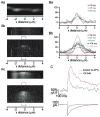Induction and expression rules of synaptic plasticity in hippocampal interneurons
- PMID: 21195098
- PMCID: PMC4126151
- DOI: 10.1016/j.neuropharm.2010.12.016
Induction and expression rules of synaptic plasticity in hippocampal interneurons
Abstract
The knowledge that excitatory synapses on aspiny hippocampal interneurons can develop genuine forms of activity-dependent remodeling, independently from the surrounding network of principal cells, is a relatively new concept. Cumulative evidence has now unequivocally demonstrated that, despite the absence of specialized postsynaptic spines that serve as compartmentalized structure for intracellular signaling in principal cell plasticity, excitatory inputs onto interneurons can undergo forms of synaptic plasticity that are induced and expressed autonomously from principal cells. Yet, the rules for induction and expression of interneuron plasticity are much more heterogeneous than in principal neurons. Long-term plasticity in interneurons is not necessarily dependent upon postsynaptic activation of NMDA receptors nor relies on the same postsynaptic membrane potential requirements as principal cells. Plasticity in interneurons rather requires activation of Ca(2+)-permeable AMPA receptors and/or metabotropic glutamate receptors and is triggered by postsynaptic hyperpolarization. In this review we will outline these distinct features of interneuron plasticity and identify potential critical candidate molecules that might be important for sustaining long-lasting changes in synaptic strength at excitatory inputs onto interneurons. This article is part of a Special Issue entitled 'Synaptic Plasticity & Interneurons'.
Copyright © 2011 Elsevier Ltd. All rights reserved.
Figures



Similar articles
-
Voltage-controlled plasticity at GluR2-deficient synapses onto hippocampal interneurons.J Neurophysiol. 2004 Dec;92(6):3575-81. doi: 10.1152/jn.00425.2004. Epub 2004 Aug 25. J Neurophysiol. 2004. PMID: 15331617
-
Input-specific learning rules at excitatory synapses onto hippocampal parvalbumin-expressing interneurons.J Physiol. 2013 Apr 1;591(7):1809-22. doi: 10.1113/jphysiol.2012.245852. Epub 2013 Jan 21. J Physiol. 2013. PMID: 23339172 Free PMC article.
-
Differential regulation of metabotropic glutamate receptor- and AMPA receptor-mediated dendritic Ca2+ signals by presynaptic and postsynaptic activity in hippocampal interneurons.J Neurosci. 2005 Jan 26;25(4):990-1001. doi: 10.1523/JNEUROSCI.4388-04.2005. J Neurosci. 2005. PMID: 15673681 Free PMC article.
-
LTP and LTD in cortical GABAergic interneurons: emerging rules and roles.Neuropharmacology. 2011 Apr;60(5):712-9. doi: 10.1016/j.neuropharm.2010.12.020. Epub 2010 Dec 23. Neuropharmacology. 2011. PMID: 21185319 Review.
-
Role of microcircuit structure and input integration in hippocampal interneuron recruitment and plasticity.Neuropharmacology. 2011 Apr;60(5):730-9. doi: 10.1016/j.neuropharm.2010.12.017. Epub 2010 Dec 30. Neuropharmacology. 2011. PMID: 21195097 Review.
Cited by
-
Revisiting AMPA receptors as an antiepileptic drug target.Epilepsy Curr. 2011 Mar;11(2):56-63. doi: 10.5698/1535-7511-11.2.56. Epilepsy Curr. 2011. PMID: 21686307 Free PMC article.
-
Long-term plasticity in identified hippocampal GABAergic interneurons in the CA1 area in vivo.Brain Struct Funct. 2017 May;222(4):1809-1827. doi: 10.1007/s00429-016-1309-7. Epub 2016 Oct 25. Brain Struct Funct. 2017. PMID: 27783219 Free PMC article.
-
Synaptic Plasticity in Cortical Inhibitory Neurons: What Mechanisms May Help to Balance Synaptic Weight Changes?Front Cell Neurosci. 2020 Sep 4;14:204. doi: 10.3389/fncel.2020.00204. eCollection 2020. Front Cell Neurosci. 2020. PMID: 33100968 Free PMC article. Review.
-
Metaplasticity at the addicted tetrapartite synapse: A common denominator of drug induced adaptations and potential treatment target for addiction.Neurobiol Learn Mem. 2018 Oct;154:97-111. doi: 10.1016/j.nlm.2018.02.007. Epub 2018 Feb 9. Neurobiol Learn Mem. 2018. PMID: 29428364 Free PMC article. Review.
-
Control of neuronal ion channel function by glycogen synthase kinase-3: new prospective for an old kinase.Front Mol Neurosci. 2012 Jul 16;5:80. doi: 10.3389/fnmol.2012.00080. eCollection 2012. Front Mol Neurosci. 2012. PMID: 22811658 Free PMC article.
References
-
- Anwyl R. Metabotropic glutamate receptor-dependent long-term potentiation. Neuropharmacology. 2009;56:735–740. - PubMed
-
- Bats C, Groc L, Choquet D. The interaction between Stargazin and PSD-95 regulates AMPA receptor surface trafficking. Neuron. 2007;53:719–734. - PubMed
-
- Bliss TV, Collingridge GL. A synaptic model of memory: long-term potentiation in the hippocampus. Nature. 1993;361:31–39. - PubMed
Publication types
MeSH terms
Substances
Grants and funding
LinkOut - more resources
Full Text Sources
Miscellaneous

